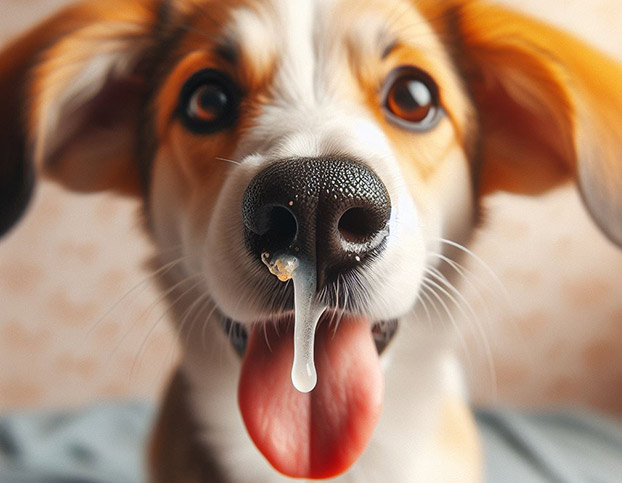Our furry friends, with their wagging tails and wet noses, bring immense joy to our lives. But what happens when that adorable wet nose turns into a runny faucet? This blog delves into nasal discharge in dogs, discussing its causes, treatments, and the crucial role of specialized medical tests like rhinoscopy.
Normal Nasal Moisture
Dogs normally have moisture in their nasal passages, and this can even be seen as moisture on the nose and around the nostrils, the so-called “wet nose”. This moisture serves several essential functions:
- Moistening and Protection: The nasal mucosa produces mucus to keep the nasal passages moist and prevent them from drying out. This moisture helps trap dust, debris, and potential pathogens.
- Olfaction Enhancement: Dogs rely heavily on their sense of smell. The thin layer of mucus over the olfactory epithelium enhances the detection of scent molecules.
- Immune Defense: The mucus is a barrier to help prevent infections.
Common Causes of Nasal Discharge
- Allergies: Dogs can develop allergies to environmental factors (pollen, dust, mold) or certain foods. Allergic reactions lead to clear nasal discharge, sneezing, and itching.
Treatment involves identifying triggers and managing symptoms. In addition, newer specific canine allergies medications are available that may help to improve allergic nasal symptoms. - Infections: Bacterial, viral, parasitic and fungal infections can cause nasal discharge. Signs include thick mucus, bad breath, and sometimes fever. Specific treatment depends on the type of infection. For bacterial infections, it is important to remember that bacteria normally inhabit the nasal passages, and in order for bacteria to establish an infection, some other problem almost always precedes this. Therefore, bacterial infections are almost always secondary to an inciting cause. Antibiotics may temporarily improve the nasal discharge, but once they are stopped, the symptoms typically return.
- Foreign Objects: Grass, plant material, food or other objects can get lodged in the nasal passages. Frequent, excessive sneezing, pawing at the nose/face and unilateral discharge (from one nostril) may indicate a foreign body. We use rhinoscopy to identify these objects and remove them without the need for surgery.
- Dental Issues: Infected teeth, gum disease, or tooth root abscesses can lead to nasal discharge. The roots of the upper teeth can become diseased and erode into the nasal cavity (oronasal fistula) allowing food and water to enter the nasal cavity from the mouth. Foul-smelling breath often accompanies dental problems. A thorough dental examination (often with dental X-rays) is needed to identify these problems.
- Tumors and Polyps: Nasal tumors (cancerous) or polyps (benign) obstruct airflow and cause discharge. Other signs may include noisy breathing, snoring, bloody nose and facial or nasal swelling. Diagnosis involves rhinoscopy for visual inspection and biopsies, and sometimes imaging (X-rays, CT scan).
- Idiopathic Lymphoplasmacytic Rhinitis: This is a chronic inflammatory disease of the inside of the nasal cavity of unknown cause (idiopathic). Chronic sneezing and nasal discharge is typically frequent. This condition may be due to an abnormal immune response to inhaled allergens, bacteria or viruses. Persistent, long-term nasal passage inflammation can lead to erosion and destruction of the mucosa (lining of the nose) and underlying nasal turbinates (nasal bones), leading to bloody nasal discharge (epistaxis).
The Role of Rhinoscopy in the Evaluation of Nasal Discharge
Rhinoscopy , a specific form of endoscopy, is a valuable diagnostic tool that we utilize almost every day and allows direct visualization of the nasal passages as well as biopsy of abnormal tissue, and removal of inhaled foreign material.
- Procedure: A flexible or rigid endoscope is inserted through the nostrils or inserted through the mouth and retroflexed about the palate to view the nasopharynx. Projected onto a monitor for viewing, this provides visual inspection of the inside of the nasal cavity and surrounding area. Real-time images reveal the nasal lining, structures, and any abnormalities.
- Indications for Rhinoscopy: Persistent discharge unresponsive to initial treatments. Suspected tumors, polyps, or foreign bodies. Chronic sneezing or nasal bleeding. Nasal or facial deformity.
- Benefits: Accurate diagnosis: Rhinoscopy helps to visually identify the underlying cause or abnormalities. Guided biopsies: Samples can be collected for analysis directly through the scope without the need for surgery or cutting.
Other Diagnostic Tests for Nasal Discharge
In addition to rhinoscopy, other tests are frequently performed in the search for the cause of nasal discharge, sneezing or bloody nose:
- Blood tests: Evaluation of red blood cells, white blood cells, platelets, coagulation (clotting) profile and antibody levels to various infections.
- Imaging: X-rays and CT scan imaging can help to evaluate bony destruction, tooth root abscess and masses.
- Culture: A direct swab of the nasal cavity or of any nasal discharge that is collected can be cultured for bacteria.
- PCR Swab: Long before COVID-19 familiarized the world with the term “PCR swab”, veterinarians used PCR to detect the DNA or RNA of various bacteria and viruses other than SARS-CoV-2.
When to Seek Veterinary Help
- Persistent Discharge: Consult a veterinarian promptly.
- Behavior Changes: Watch for appetite, energy, or breathing pattern changes.
- Blood in Discharge: Immediate attention required.
- Unilateral (one-sided) Discharge: Consider a foreign body or tumor.
Remember, a healthy nose is crucial for a dog’s overall well-being. A healthy diet, regular check-ups, getting the recommended vaccinations, early intervention, and collaboration with your veterinarian ensure those sniffers stay in top shape!
Contact Us – We Can Help
If you have any questions about nasal disease in dogs, or concerns about your own dog’s nasal health, don’t hesitate to contact us, we can help.

Author:
James Woods DVM, MS, DACVIM (SAIM)
Ph: (912) 721-6410
Contact Us
